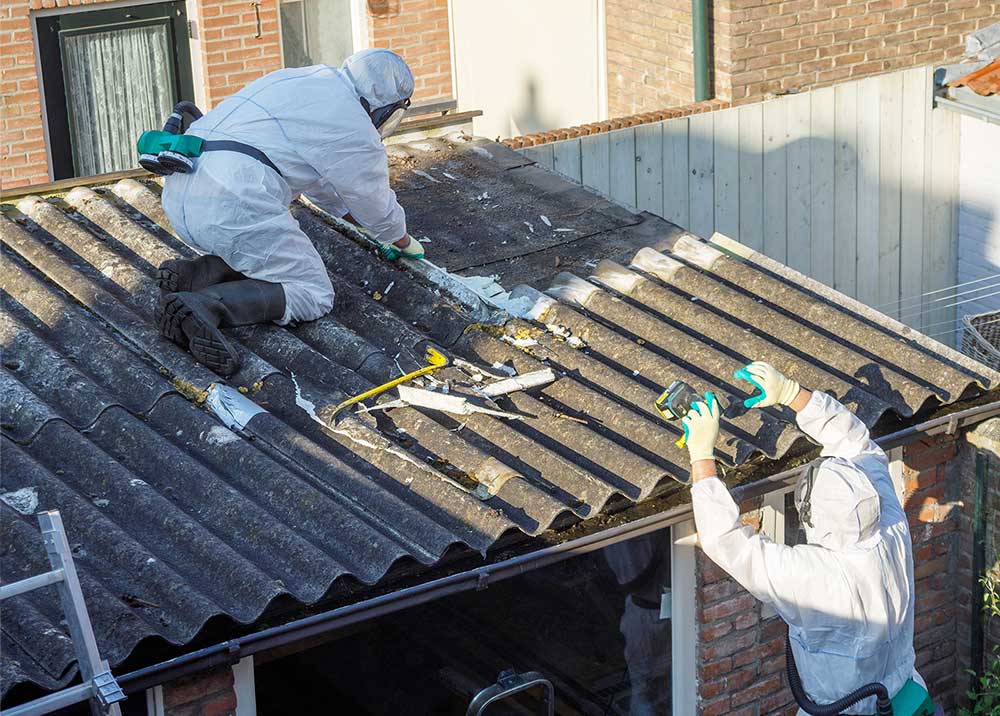Prepare to embark on a mysterious journey as we unravel the mysteries surrounding asbestos roof tiles. While these tiles may not present an immediate threat, their presence should not be taken lightly. Read this expert guide to discover the art of correctly identifying and safely disposing of these materials.
Locating asbestos roof tiles is a skill known only to a select few, such as chartered surveyors. These tiles, derived from the mineral-rich serpentinite rock, found their way into a surprising array of products, including roofing materials, during the 20th century. Notably, six distinct types of asbestos exist. The most common three are distinguishable by their vivid hues: blue, brown, and white. Of these, the white variant, known as ‘chrysolite,’ poses the most minor peril. Predominantly used in the construction industry as cement fibre, it is the most prevalent type of asbestos found in materials, collectively referred to as Asbestos Containing Materials (ACMs).
But what do asbestos roof tiles look like? One can spot the most conspicuous examples adorning inter-war bungalows, with their faded red tiles arranged in a distinctive diamond pattern. Progressing through time, some artificial slates were crafted from asbestos cement, betraying their identity through a peculiar transformation from original black to an unnatural, mottled pale grey or blue. It is worth noting that non-asbestos materials emerged in 1984, rendering ACMs outdated, although a few builders may have continued with their installation for a time. However, the most prevalent form of asbestos roofing manifests as corrugated asbestos cement sheeting, commonly found on garages and sheds but thankfully less prevalent on primary roofs. Additionally, cement fibre boarding frequently graces soffits, eaves, and occasionally, gutters and downpipes.
Now, the burning question: just how perilous are these asbestos roof tiles? It was in the mid-1980s that the UK government banned the most hazardous asbestos variants, finally outlawing the manufacture and supply of all asbestos in late 1999. As early as the 1920s, astute physicians suspected inhaling asbestos fibres could lead to debilitating lung diseases, culminating in mesothelioma and respiratory afflictions. However, not all ACMs are created equal. The gravest offenders, deemed ‘friable,’ are prone to crumble or disintegrate upon the slightest touch, liberating harmful fibres into the air. Examples include old insulation and pipe lagging. On the other hand, asbestos cement materials used in roofing are categorized as ‘non-friable,’ as the asbestos fibres are bound within the material.
Generally, asbestos roof tiles in good condition pose no immediate risk, as the cement effectively confines the asbestos. Consequently, these tiles can usually be left undisturbed. However, danger lurks when the tiles sustain damage or deterioration, causing the cement to weaken and potentially release fibres into the air. Given that roof coverings face the relentless onslaught of the elements, they are susceptible to localized storm damage, such as chipped corners. In such cases, any liberated fibres should ideally disperse into the open air, diminishing potential harm. Nevertheless, roofs lacking underlay beneath flawed tiles bear a latent risk of accumulating dust in lofts, which may test positive for ACMs.
If you suspect the presence of asbestos roof tiles, establishing the existence of ACMs is difficult. Initially, check if any manufacturer’s identification mark is imprinted on the undersides of the tiles. ‘AC’ signifies asbestos, while ‘NT’ denotes non-asbestos tiles. Regrettably, only a meagre 1 in 20 tiles bear such markings, necessitating the removal and examination of multiple tiles. Alternatively, a wiser course of action involves dispatching a solitary tile to a laboratory for testing. Moreover, an Asbestos Management Survey conducted by a UKAS-accredited company can be employed to provide comprehensive insights. Meanwhile, as a precaution, refrain from permitting anyone to ascend the roof or enter the loft without appropriate Personal Protective Equipment (PPE).
Disposing of asbestos roof tiles poses an intriguing problem. The most straightforward approach entails soliciting quotes from reputable roofing contractors to replace roofs adorned with asbestos slates or tiles. Seasoned roofers equipped with adequate asbestos training (minimum Non-Licensed training) possess the expertise to assess the associated risks, often managing them on-site with minimal fanfare and expense. Ensure that the quotes encompass all costs related to stripping, removing, and disposing of the existing roof coverings and implementing protective measures to isolate the house during the operation.
While ACMs are generally considered safe if undamaged, avoiding engaging in DIY endeavours is advisable. Nevertheless, disposing of asbestos roof tiles is not legally restricted, and specific Council tips may accept ACMs. In some instances, councils even arrange collections for a fee. When undertaking disposal, encase the materials in sturdy plastic rubble bags, exercising caution to prevent their fragmentation and the subsequent generation of hazardous dust particles. In the event of a broken roof tile, promptly dampen it with water to minimize the escape of airborne fibres. Lastly, donning proper PPE—gloves, dust masks, safety goggles, and suitable protective clothing—is an imperative safeguard throughout the process. Prepare for the perplexing task ahead; the safe identification and disposal of asbestos roof tiles demand unwavering diligence and care.

